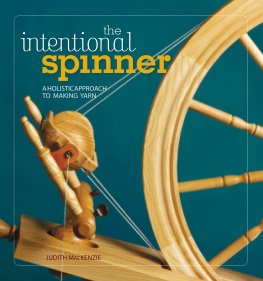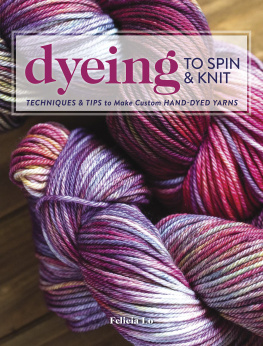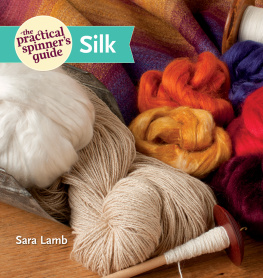
INTERTWINED
The Art of Handspun Yarn, Modern Patterns, and Creative Spinning
BEVERLY MASSACHUSETTS
QUARRY
BOOKS
LEXI BOEGER
To the Reverend Dr. Joel nano Warner
CONTENTS

Introduction: A Balanced Yarn
Knit
Crochet
Felt
Weave
Other
A Balanced Yarn
Handspun yarn is more than simply yarn. It is a creative endeavor. It has an intrinsic integrity that is built into the yarn by the very act of spinning. Every inch has been fed through the hand of the craftsperson. Formed. Changed. Created. Thought-through. Felt.
Handspun yarns are made by conscious beings, not unconscious machines. This imbues them with an internal energy, giving them character and uniqueness. Each yarn is a reflection of the individual spinner who made it. It is this quality that makes handspun yarn so amazing to work with. As you work through a skein, you can see, inch by inch, the decisions that the spinner made. It passes before you just like a story.
Though a spinners individuality is reflected in a yarn, the process the yarn goes through reaches beyond the individual spinner. The spinner is just one stop on a journey, one in which the yarn is perpetually destined for new hands. When you wrap yourself in a scarf made with handspun yarn, you can trace each stitch the knitter made. This connects you to the knitter through his or her work, just as the knitter is connected to the spinner through theirs. The yarn passed through the knitters fingers just as it passed through the hand of the spinner; the fiber passed through the hand of the spinner just as it passed through the hand of the person who dyed it, and so on through the hand of the farmer who raised the animal, sheared it, and washed it. This phenomenon joins together hands through a single strand that stretches across spaces and through time. The yarn becomes a bond that connects separate people into a collaborative group, all working toward a common creation. The final form that the yarn takes is not the work of one artisan, but the synthesis of many.
A balanced yarn is one that beams with individuality yet is a record of this collective history. A spinner achieves balance if they can be proud of their creativity while being comfortable sharing the credit. This is a way of thinking that can be applied beyond the craft of spinning. Each piece of a puzzle needs to be unique, yet each piece must lend itself to the whole to make it work. This is the balance.

Traditionally spun yarn by Lou Andersen, Lofty Lous, Placerville, California; nontraditional yarn by Laurence Pocztar (France) of LaineZinZin
The Art of Craft
The dramatic changes in how yarns are spun is creating some shifts and rifts within the handspinning community, and as a result, the craft of handspinning is experiencing some growing pains. The conventional view of spinning is that a yarn must function as a component to a final material or garment. Its value lies in how well it fulfills this role. Qualities such as balance, strength, and consistency are regarded as the hallmarks of good spinning. Traditional spinning does not diverge far from its roots, using tried and true fibers such as wool, cotton, and silk. Spinning has reflected a close tie to its historic past and a satisfaction in maintaining these historic methods and materials.
But things are changing. There is an explosion of new materials being spun, expanding the definition of what constitutes yarn. New techniques that break all the traditional rules of spinning are changing the definition of how yarn is made. Yarn has become a medium for personal, social, and creative expression.
This shift happens in all craft genres, as the tension between the traditional roots and function of a craft and the human drive for creativity and fulfillment of our deeper intellectual and creative needs diverge. This tension often creates a rift between the proponents on either side, and the craft becomes divided into opposing groups. Sometimes these groups even become alienated from each other. The traditional group may view the diverging group as illegitimate newcomers, while the new group sees the traditional craftspeople as short-sighted and obsolete. Such a black-and-white view of the situation is not necessary, however. Not only is it a negative way to operate, but it also robs both groups of the opportunity to learn from each other. Both sides are valid, and both views are necessary for a craft to be relevant and balanced.
Striking a balance between tradition and innovation is imperative for keeping spinning from becoming a forgotten art. A craft is only truly viable if it resonates within the culture. Make it applicable to the times, and it will grow and change with the times. Arts are lost when a culture cant relate to them, either because technology makes the skill obsolete or because there is no longer a need for the product. This happened to handspun yarn as a result of two inventions: in 1764, James Hargreaves invented his famous multi-spool spinning wheel, called the Spinning Jenny. This was followed in the early eighteenth century with the invention of wool and cotton mills. The advent of commercial machinery that could produce consistent, strong, balanced yarns quickly and cheaply took handspinning out of societys necessary repertoire of skills. Only a small number of people continued to practice the art, and the skill has become a novelty, moving from the socioeconomic stage to the personal realm. It is enriching for the few who pursue it, but it no longer has much influence in our popular culture.
Adapting to the aesthetics of current popular culture will actually preserve traditional spinning as it opens the craft up to new advancements. Getting a larger number of people interested in handspun yarn will ensure that the craft is not lost. There are all types of knitters. Some will embrace the new innovative styles while others will prefer the traditional forms.
The Function of Creativity
Hopefully, most people will learn to appreciate both traditional spinning and its contemporary innovations for their different but equally valuable qualities. Skill and functionality are the building blocks of good spinning. Every spinner should be able to spin perfectly balanced, sound yarn first. This is the only way to gain a full understanding of the mechanics of yarn making and how the fibers behave. You have to know the rules before you can break them. There is an inverse relationship between control and creativity. Its like realism and abstraction. Say you are painting a leaf. The more realistically you try to paint it, the more abstract it becomes. The closer you observe the subject and try to replicate its every detail, the more your rendition dissolves into blurs, shapes, and colors. It is the scrutinizing, close observation of the reality that discloses the extreme abstraction of the painting.
The same thing happens when trying to spin perfect yarn. No matter how even the yarn or how smooth the roving, there is inevitably a little lump, a fiber out of place. You realize that perfection cannot be attained, that it is forever a receding horizon. The pursuit of perfection spotlights the incidences of imperfection. The investigation of imperfection leads to creativity. A route to creativity is found through the attempt to master the skill. You can focus so closely on perfect mastery that you go through the eye of a needle and you come out the other side into a creative world thrown wide open.
Next page






